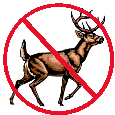USDA National Wildlife Research Center Symposia
Date of this Version
August 1995
Abstract
The deer repellent literature is fragmented and hard to interpret because there is no standard method to measure repellent effectiveness. Instead, studies differ in (1) which repellents were tested, (2) which plant or food was used as a carrier, (3) repellent concentration, (4) test duration, (5) experimental design, and (6) criteria for success. Despite these difficulties, we analyzed the literature seeking over-arching trends in repellent effectiveness. Deer-Away Big Game Repellenta (BGR) and predator odors were usually more effective than other repellents. In most field tests, the best repellents usually reduced deer damage by < 60%. There was no significant difference in the effectiveness of area repellents and contact repellents. Factors affecting repellent effectiveness include relative palatability of the plant to be protected, size of local deer populations, availability of alternative forage, weather, amount and concentration of repellent used, and test duration. White-tailed deer (Odocoileus virginianus) and mule deer (0. hemionus) may respond differently to predator odors; with the exception of this, differences among deer and elk (Cervus canadensis) in their responses to various repellents were not statistically significant.

